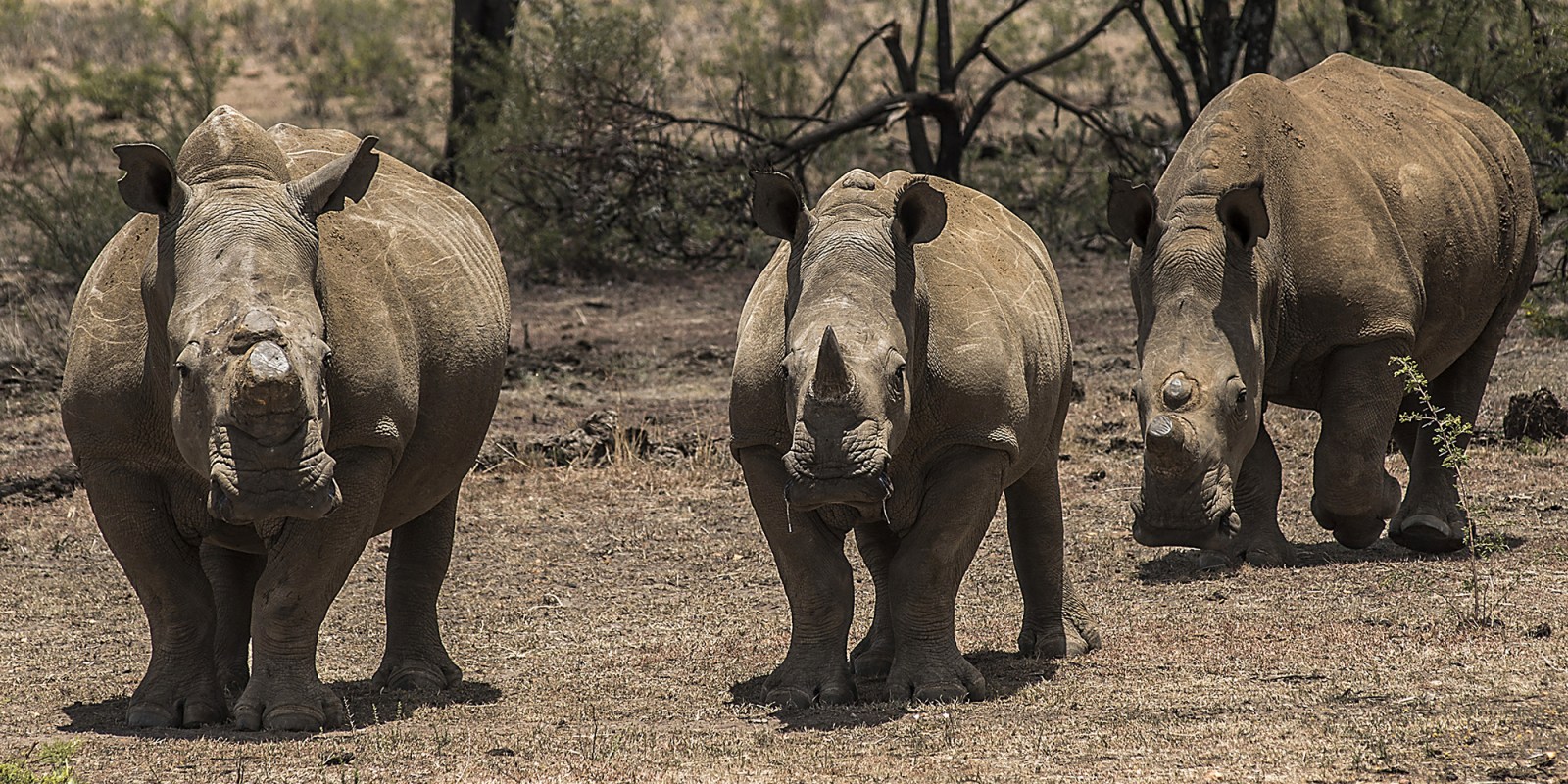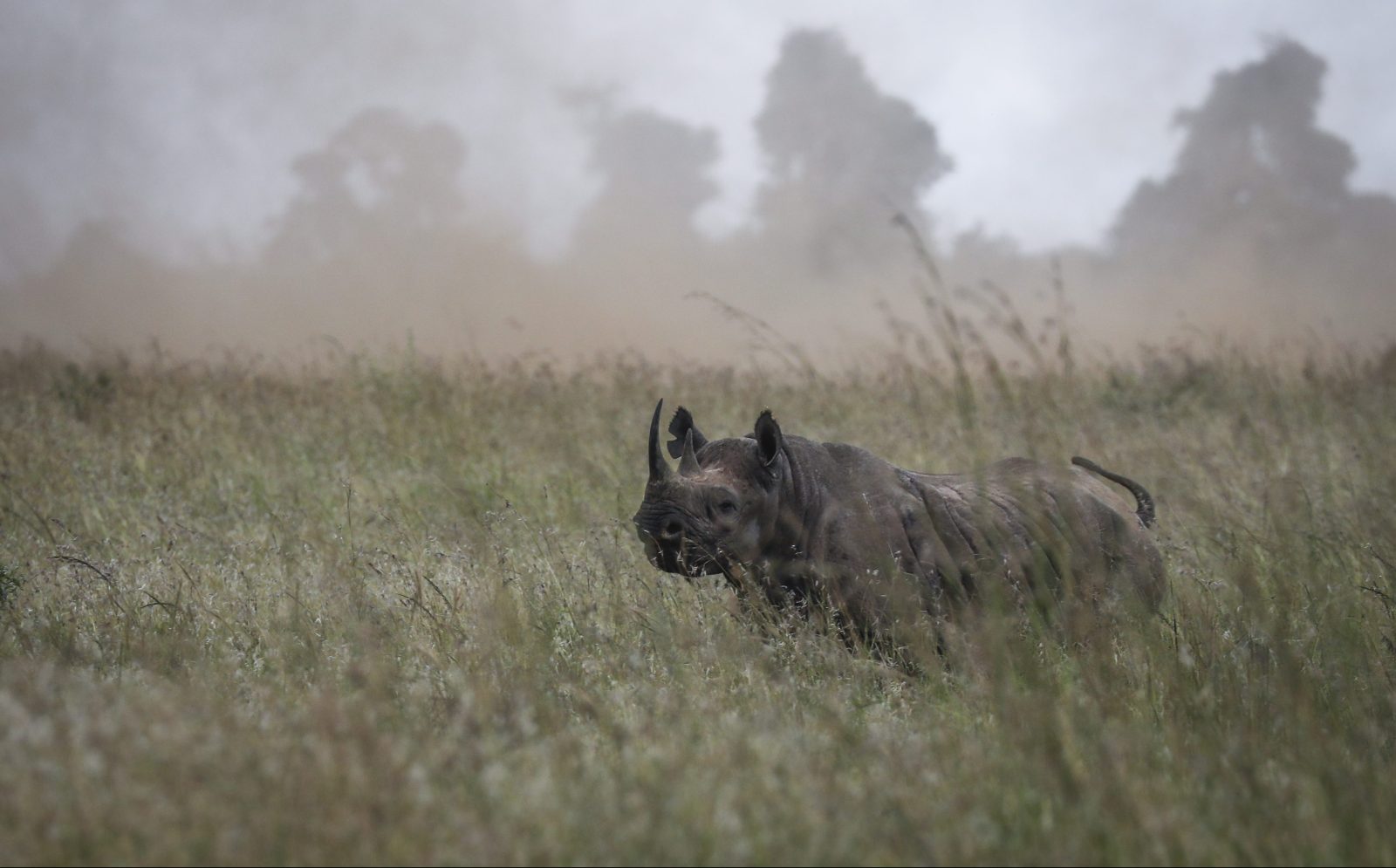By Helena Kriel• 19 May 2021

Seha, the rhino. (Photo: Saving the Survivors)
Seha’s story is a synecdoche for a species under terrible threat from poaching and for the people who care.
It’s 2014. On a private farm, a young rhino bull tumbles to the ground, breaking his foetal sac. He lies, seemingly inert. His mother uses her horn, gently urging him to stand. He’s wobbly, still a creature of the womb, where he was suspended for 480 days. His mother’s warm teats are ready for suckling. First day on planet Earth. Welcome, young rhino.
It’s wild where he lives. The silky buffalo grass grows as high as his mother’s flank. When they walk, the calf at her side disappears.
By the age of two, he’s fully grown and follows his instinct, venturing into the bush, reading the messages in the middens. He knows when he’s entering the territory of a bigger bull and avoids him. He’s still young, doesn’t want trouble, but he feels the power inside him. In time, he’ll be a force to be reckoned with.
On full-moon nights, the trees are lined with silver. On such a night his life will change.
While patrolling in the silver night, he sees something strange: three men. They’re armed with military-grade weapons. He stares a moment, then runs. They fire. He falls. Blinding burning. And a wash of something warm. Then all is darkness.
Air where there was a horn
When he wakes, there’s an inferno in his head, air where there was a horn. The geography of his face has changed. There are flies. He can’t see, he can’t understand why the sun is burning into his head. He manages to stand, then falls. Finally, he gets up and walks in a daze.
Day becomes night, becomes day. The flies buzz in his brain. He’s on fire, growing weaker.
When the police come across him, staggering along the fence line, they see blood, sinus, a concave of red jelly. Most of his head has been hacked away. On either side of the morass, his eyes can be seen, but only just. They vomit in shock.
“Why is this rhino walking with no face?” they ask the owners.
“This rhino means nothing to us now,” they say. “Just shoot him.”
But the police, affected by the bleeding hulk, contact Saving the Survivors, a team of vets working to protect Africa’s endangered wildlife. This is how the man who perseveres meets the rhino who won’t give up.
Dr Johan Marais, a wildlife vet, encounters the 2-tonne creature with only half a face. It knocks the breath out of him. How, how, how are they going to save him?
“We’ll call him Seha, short for Sehawukele,” Marais says. “It means ‘Have mercy on us’.”
This is the start of a journey that will take six years.
Healing hands
Seha is transported to a sanctuary and put into a paddock to allow easy access to him.
Does Seha understand he has been placed in healing hands? Marais, known for his tenacity, begins work. There is so little skin left on the young rhino’s face that orthopaedic screws are drilled directly into his skull. This secures the cover needed to protect the gaping crevasse from maggot-laying flies.
With twine, Marais binds the two sides of the wound in his face a little closer together and covers the crater with elephant hide. One operation follows another. Seha, a true survivor, endures 30 operations in five years.
It is 2021. In the paddock, Seha stands alone. Instead of the wind in the grass, the splatter of rain, the eagle’s high call, the grunt of the lion calling across open spaces, this young rhino has come to know the sounds of human voices and tractors, the scrape of a rake across gravel.
But Seha is alive, testament to courage and healing hands. He has sired a calf and the beauty of young Daniel shows the perfection of his genes.
How could Seha know that for 50 million years his species has been spreading seeds, proliferating grasses and preventing fires by close-cropping burnable grasses, fertilising the soil and creating high-sequestering carbon sinks? How could he know that he, too, is a climate warrior and he affects the biodiversity balance of the planet?
Seha remains now in a paddock. His story is a synecdoche for a species under terrible threat from poaching and for the people who care.
When one regards him, he seems strong, but he looks unimaginably sad. He hasn’t lost his wild spirit and, if you venture in, he’ll chase you. Will this powerhouse again feel the breeze shift the thorn trees and see vervet monkeys jump and jabber? Doesn’t he deserve it?
All this inordinate suffering … for what? For the illusion of what this horn may do for humans? Could it harden an erection, help indigestion, take away a headache, cure cancer? His horn is hair!
A world away, Seha’s horn brings status and looks good on a table, filled with fruit. Maybe, sliced and polished, it now clinks on an arm as a bangle. Some of it would have been sprinkled on a drink as powder – yes, powder – from a creature whose ancestors once mixed with dinosaurs.
How unutterably sad. For a bangle. The lie of a cure. An erection gone wrong. A party trick. DM168




